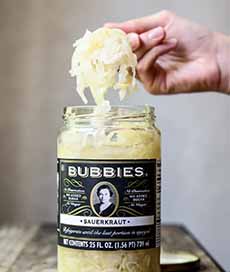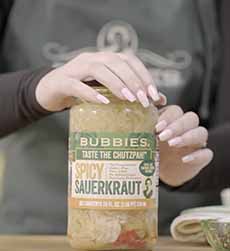For July 4th: A Red, White & Blue Hot Dog Pizza Recipe
|
In addition to hot dogs on the grill, here’s something different for July 4th week: a red, white, and blue pizza. You can also make the pizza on the grill (here’s how). When you don’t want a red, white, and blue theme, use white waxy potatoes instead of the blue variety. Or, ditch the sliced potatoes, add more hot dogs to fill in the spaces, and top the pizza with French fries. If you want to use frozen fries, you can top the Ingredients We microwaved the potato slices for 15 seconds to al dente so they would bake to the optimal tenderness. 1. BAKE the pizza until bubbly. Because the fries take a bit longer (30 minutes compared to 25 to 30 minutes for a crust), consider baking the fries until golden and top the pie when it comes out of the oven. 2. FRENCH FRY OPTION: Frozen fries and pizza crusts bake at 450°F, so you could also top the pizza with the fries for the last 5 minutes of baking, to warm them up. Thanks to Bubbie’s for the idea, which uses Bubbies Sauerkraut. Bubbies Spicy Sauerkraut contains red pepper slices. > The history of Independence Day. > The history of sauerkraut follows. > July is National Hot Dog Month. The third Wednesday in July is National Hot Dog Day. |
|
|
|
THE HISTORY OF SAUERKRAUT Sauerkraut is a national dish of Germany, and is known by its German name in English-speaking countries (the English translation is “sour cabbage”). It’s also a traditional dish in the countries of Central and Eastern Europe, in France and The Netherlands. However, sauerkraut did not originate in Germany. The pickled cabbage dish suan cai dates to at least the days of the building of the Great Wall of China*. The Romans also pickled forms of cabbage, which could be the source of modern-day European sauerkraut. However, a competing theory calls out the Mongol conquests of the 13th and 14th centuries. The Mongols brought the method of preserving cabbage by lactic acid to Europe, after conquering parts of China, where lactic fermentation was a well-known method of preservation. (If the Mongols did not yet know the lactic fermentation process, they learned about it in China.) Each non-English-speaking country has its own name for sauerkraut, and regional variations abound. Today, the per capita consumption of sauerkraut is higher in the U.S. and France (where it is called choucroute) than in Germany [source]. CHECK OUT WHAT’S HAPPENING ON OUR HOME PAGE, THENIBBLE.COM. |
||





